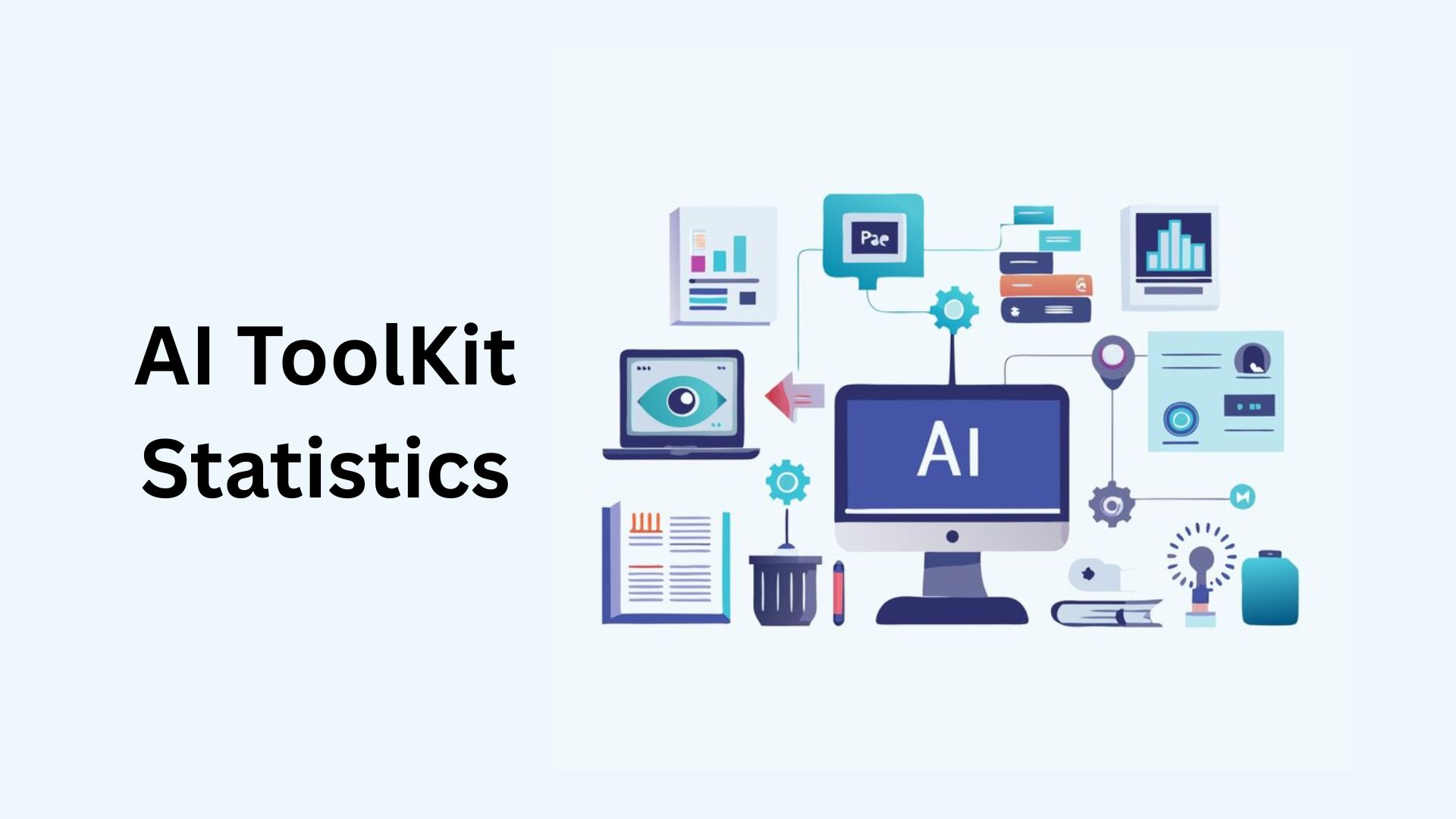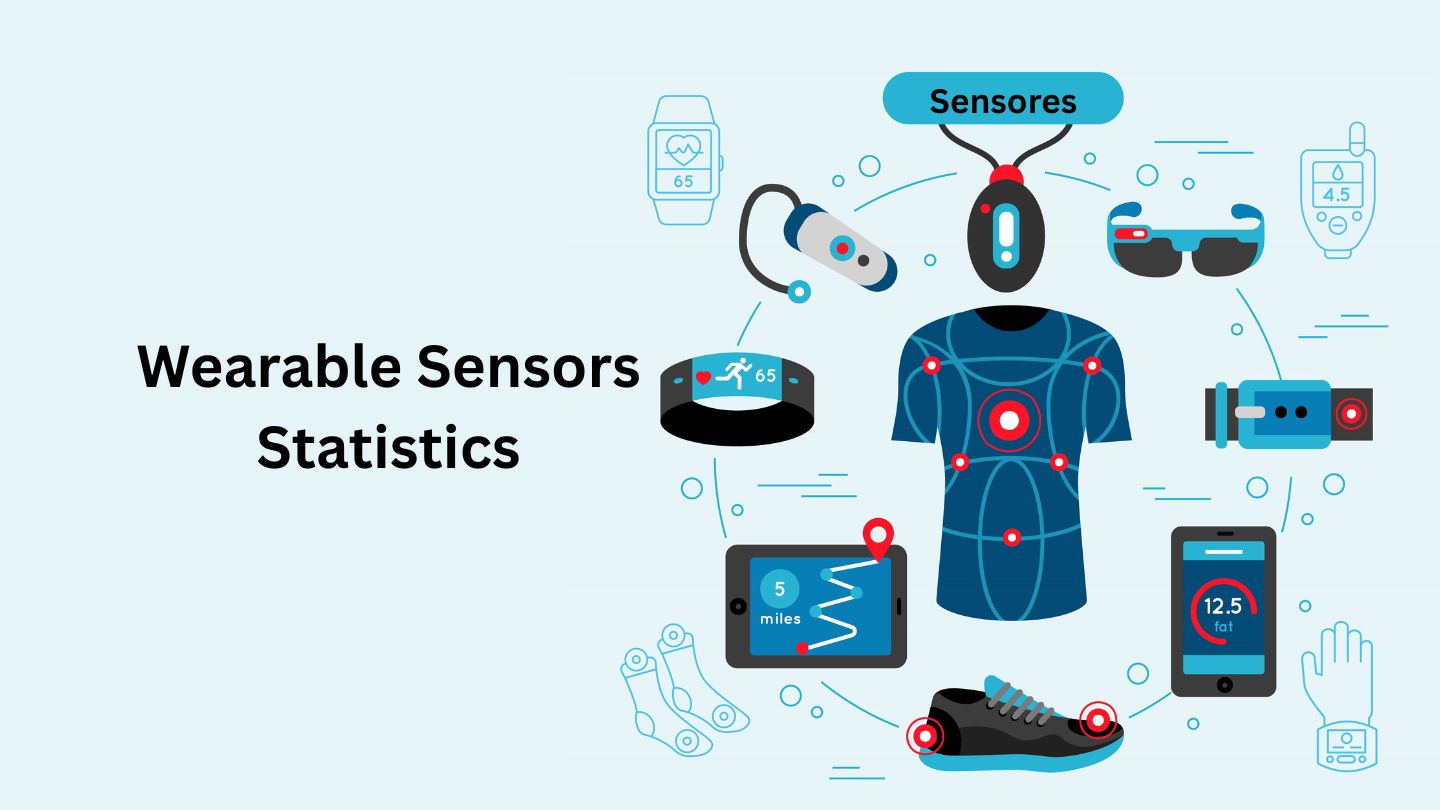Gluten-Free Diet Statistics By Benefits, Habits, Allergies, Celiac Diseases and Facts

Updated · Jan 13, 2025


TABLE OF CONTENTS
- Introduction
- Editor’s Choice
- What Is A Gluten-Free Diet?
- A Simple Food List for the Gluten-Free Diet
- General Gluten-Free Diet Statistics
- Gluten-Free Diet Health Benefits
- Gluten-Free Diet Market Growth Projections Statistics
- Allergies And Celiac Diseases Statistics
- Gluten-Free Diet Demographics Statistics
- Gluten-Free Shopping Habits Statistics
- Conclusion
Introduction
Gluten-Free Diet Statistics: A gluten-free diet means avoiding foods that have gluten, a protein found in wheat, barley, and rye. Most research on gluten-free diets has been done with people who have celiac disease. However, gluten can also impact other health problems, like non-celiac gluten sensitivity (NCGS). Wheat allergy happens when your body reacts to wheat proteins by making antibodies, which can cause severe reactions, including anaphylaxis.
It’s important to see a doctor who knows about stomach issues to get the right diagnosis. If you have celiac disease, it’s crucial to stay away from gluten completely to prevent serious health issues. For people with NCGS, reducing gluten in your diet might help improve symptoms. People with a wheat allergy must avoid wheat in all forms, which means they might also need to follow a gluten-free diet. We shall shed enough light on Gluten-Free Diet Statistics through this article.
Editor’s Choice
- Millennials are the biggest group following a gluten-free diet.
- Between 60% and 70% of people with celiac disease are women.
- 17 out of every 100,000 women have celiac disease, compared to 8 out of every 100,000 men. Women are most often diagnosed between the ages of 40 and 60, usually around menopause.
- The average age for being diagnosed with celiac disease is 50.
- Gluten-Free Diet Statistics stated that Celiac disease is more common in children than adults. 21 out of every 100,000 children have it, compared to 13 out of every 100,000 adults.
- People with celiac disease are mostly from North Africa, India, Finland, and the United States.
- Celiac disease rates are:
-
- 0.4% in South America
- 0.5% in Africa and North America
- 0.6% in Asia
- 0.8% in Europe and Oceania
- Caucasians are the most affected group. In the U.S., non-Hispanic white people are 4 to 8 times more likely to have celiac disease.
- The number of people with celiac disease has been increasing by an average of 7.5% every year for the past few decades.
- 1 in 100 people worldwide have celiac disease, an immune system disorder triggered by eating gluten.
- Around 18 million Americans have non-celiac gluten sensitivity.
- Gluten-Free Diet Statistics stated that about 30% of people in the U.S. are trying to eat less gluten.
- Around 40% of people buy gluten-free products because they believe they are healthier.
- The Asia-Pacific region is seeing more people choosing gluten-free products as awareness about gluten intolerance increases.
- More than 3 million Americans have celiac disease, but 83% don’t know they have it.
- Online sales of gluten-free products have grown, now making up 14% of all gluten-free product sales.
- Over 1.7 million Canadians follow a gluten-free diet, and this number is expected to keep growing.
You May Also Like To Read
- Dietary Supplements Statistics
- Vitamins And Supplements Statistics
- Health Care Devices Statistics
- Skincare Statistics
- Health And Fitness Statistics
- PTSD Statistics
- Personal Hygiene Products Statistics
- Fragrance Statistics
- Haircare Statistics
- Smartphone Addiction Statistics
- Wearable Devices Statistics
- Makeup Statistics
- Sexual Assault Statistics
What Is A Gluten-Free Diet?
Gluten-free food (GFD) is a form of consumption that totally neglects gluten, which is a protein found in wheat (including varieties like spelt, kamut, and triticale), as well as barley, rye, and oats. However, oats are sometimes debated as part of a gluten-free diet since they can be cross-contaminated with gluten from other grains.
Gluten can cause both stomach and other health problems for people with certain conditions like celiac disease (CD), non-celiac gluten sensitivity (NCGS), and wheat allergy. For these individuals, a gluten-free diet is considered an effective treatment. Still, studies show that around 79% of people with celiac disease don’t fully heal their small intestines even with a strict gluten-free diet. This is often due to accidentally eating foods with gluten. Many people believe they are following the diet correctly, but they make common mistakes without realizing it.
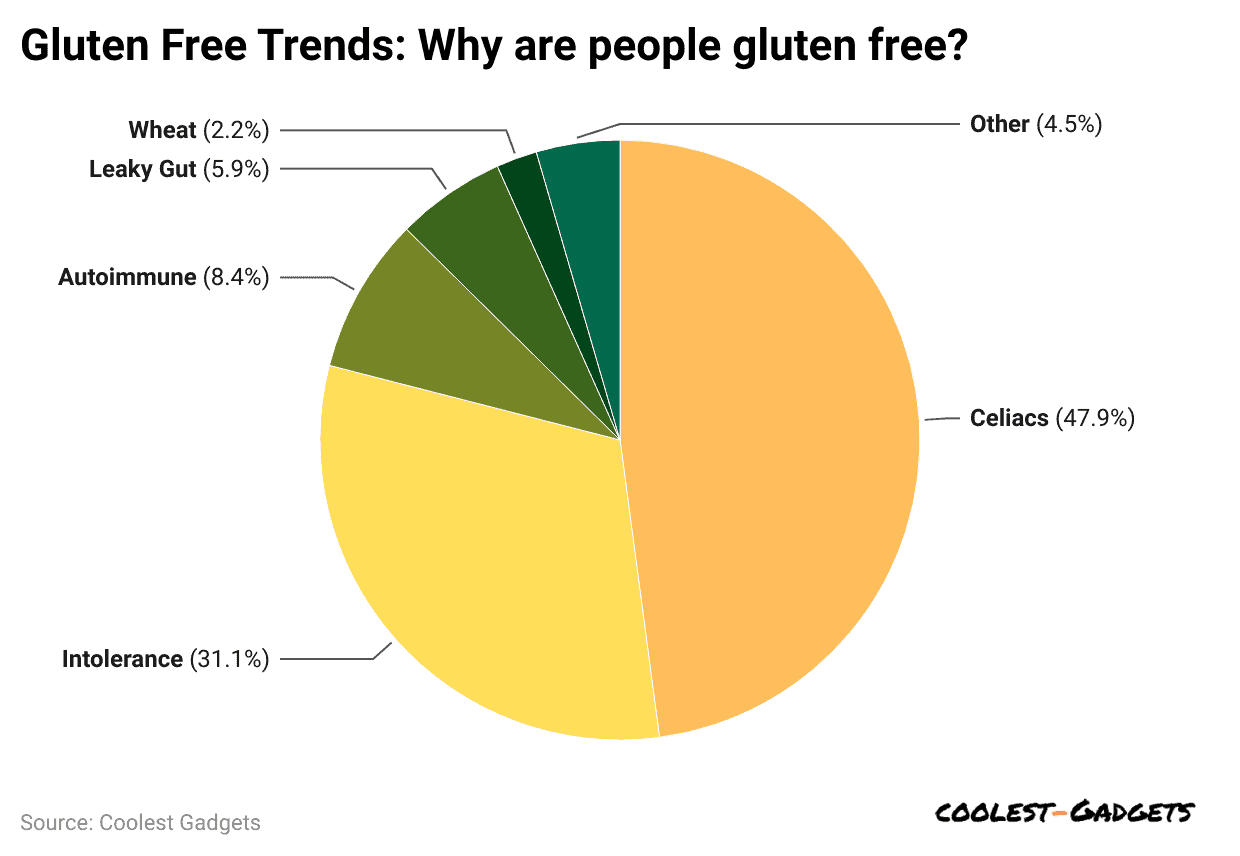 (Reference: regainyoursparkle.com)
(Reference: regainyoursparkle.com)
In some cases, a gluten-free diet may also help with symptoms of conditions like irritable bowel syndrome, rheumatoid arthritis, or HIV-related stomach issues. However, there is no strong evidence to suggest that a gluten-free diet is a helpful treatment for people with autism.
Gluten proteins don’t offer much nutritional value, and grains with gluten aren’t necessary for a healthy diet. However, if someone is not careful, replacing regular wheat products with gluten-free alternatives can lead to missing out on important nutrients like iron and B vitamins. Many gluten-free packaged products are not enriched or fortified as much as gluten-containing ones and tend to be higher in fats and sugars. Kids, in particular, often eat too many gluten-free snacks and biscuits, which can lead to unhealthy eating. Proper education on diet choices can help avoid these nutritional issues.
A gluten-free diet usually includes foods like meat, fish, eggs, milk, dairy, beans, nuts, fruits, vegetables, potatoes, rice, and corn. Some gluten-free processed foods can be included, and grains like quinoa, amaranth, and buckwheat are great alternatives for good nutrition.
A Simple Food List for the Gluten-Free Diet
With approval from your doctor, follow this list of foods to eat and avoid to help manage your health.
-
Foods to Avoid (Contain Gluten)
#1. Grains with Gluten:
- Wheat
- Barley
- Bulgur
- Rye
- Seitan (a wheat-based protein)
#2. Wheat and its Forms:
- Wheat starch
- Wheat bran
- Wheat germ
- Couscous
- Cracked wheat
- Farro
- Semolina
- Spelt
#3. Beverages:
- Most beers (unless labelled gluten-free)
- Malt drinks
#4. Other Foods to Avoid:
- Barley malt
- Some chicken, beef, and vegetable broths
- Malt vinegar
- Some salad dressings
- Veggie burgers
- Frozen meals
- Condiments
- Soba noodles
-
Foods You Can Eat (Naturally Gluten-Free)
#1. Naturally gluten-free foods:
- Fruits
- Vegetables
- Meat
- Poultry
- Fish and seafood
- Dairy
- Beans
- Legumes
- Nuts
#2. Gluten-free grains, seeds, and starches:
- Rice
- Cassava
- Corn
- Soy
- Potatoes
- Sweet potatoes
- Quinoa
- Millet
- Teff
- Nut flours
- Gluten-free oats
- Flaxseed
- Chia seeds
#3. Beverages:
- Water
- Sparkling water
- Soda
- Juice
- Sports drinks
- Wine
- Most hard liquor
- Gluten-free beer
This list will help you make better choices and stay on track with your gluten-free diet.
General Gluten-Free Diet Statistics
- According to the analysis from our research expert, the global market for gluten-free products is expected to grow at an annual rate of about 9.51% from 2022 to 2028.
- In 2021, the global gluten-free products market was worth around USD 5.80 billion, and it’s expected to increase to about USD 10.96 billion by 2028.
- This market is predicted to grow quickly due to several key factors.
- Studies show that people on a gluten-free diet often have lower levels of certain vitamins in their bodies.
- This is because gluten-free flour and baked goods usually have less fibre, iron, B vitamins, zinc, magnesium, and calcium compared to regular gluten-containing foods.
- 48% of people are on a gluten-free diet because they have celiac disease.
- Gluten-Free Diet Statistics stated that about 31% follow a gluten-free diet because they have gluten sensitivity.
- 4% follow a gluten-free diet due to a different autoimmune condition.
- Gluten-Free Diet Statistics state that about 80% of people on a gluten-free diet are trying to reduce stomach pain.
- To make gluten-free products taste better, manufacturers often add extra fat, sugar, and salt, which can be unhealthy and may lead to weight gain.
- “Organic” refers to how food is grown, processed, and packaged. However, organic foods can still contain gluten unless the packaging specifically says they are gluten-free.
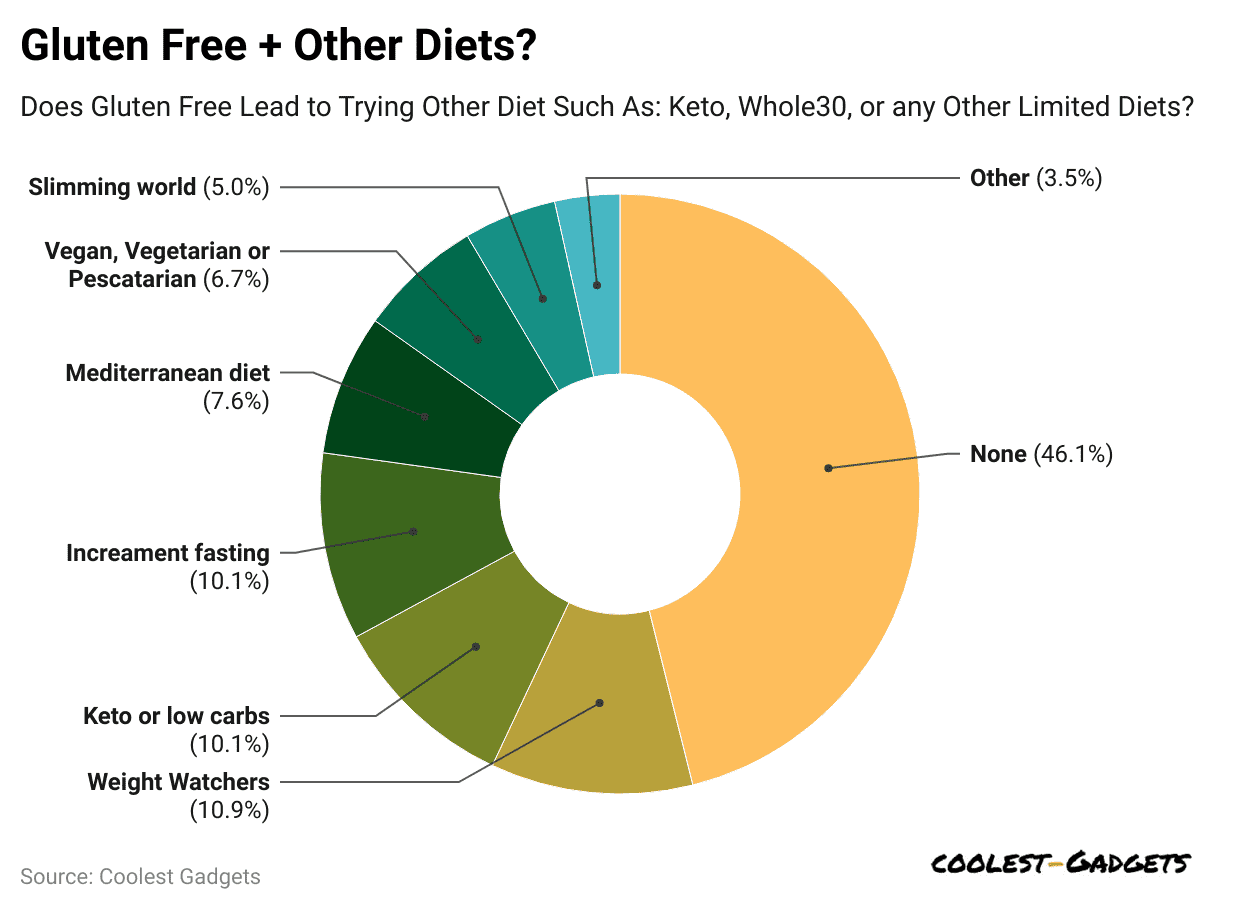 (Reference: regainyoursparkle.com)
(Reference: regainyoursparkle.com)
- Gluten-related diseases can seriously harm the body, affecting digestion and nutrient absorption.
- People with these conditions may experience stomach and bowel issues, headaches, extreme tiredness, thyroid problems, anxiety, and mood changes.
- A gluten-free label on a food item is regulated by the Food and Drug Administration (FDA) and is considered safe for people with gluten-triggered diseases.
- For individuals with gluten-related diseases, completely removing gluten from the diet is the only way to manage the condition.
You May Also Like To Read
- Fitbit Statistics
- Fitness Equipment Statistics
- Yoga Industry Statistics
- Workplace Injury Statistics
- Technology Addiction Statistics
- Workplace Stress Statistics
- CBD Statistics
- Nursing Burnout Statistics
- AI In Healthcare Statistics
- Mental Health Statistics
Gluten-Free Diet Health Benefits
For people with Celiac disease or gluten sensitivity, a gluten-free diet is essential for their health, and there are many reasons why they should avoid gluten. However, for others who don’t have these conditions, cutting out gluten may not be necessary and could even cause some problems.
In most cases, removing gluten from the diet won’t do much to reduce inflammation or improve health. It could also lead to a loss of important nutrients. Additionally, gluten-free products often contain additives to make up for the taste and texture of gluten, which may not be healthy.
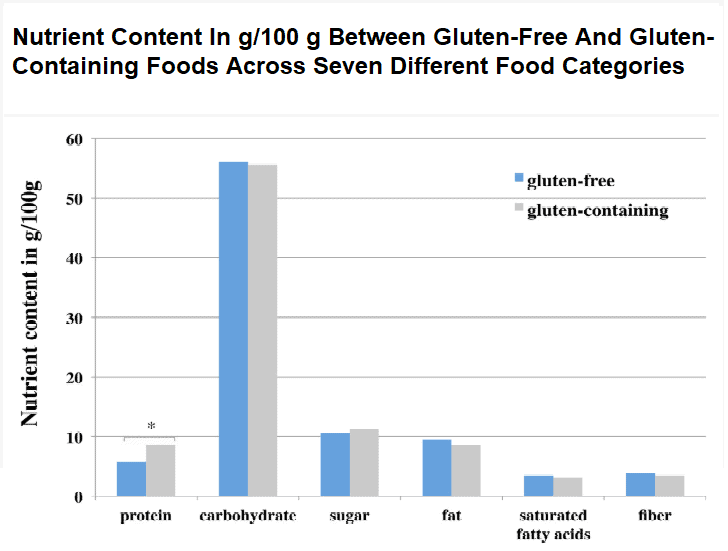 (Source: peerj.com)
(Source: peerj.com)
- Gluten-Free Diet Statistics stated that only 5% of gluten-free bread is fortified with key nutrients like calcium, iron, niacin, and thiamine.
- Many gluten-free foods have more fat and sugar than regular foods with gluten.
- A gluten-free diet can sometimes lead to weight gain.
- Giving up whole grains (which have gluten) could increase the risk of early death by as much as 17%.
- Among women on a gluten-free diet, only 31% get enough calcium, 44% get enough iron, and just 46% get enough fiber.
- For men, 63% get enough calcium, 100% get enough iron, and 88% get enough fiber.
Gluten-Free Diet Market Growth Projections Statistics
- The global market for gluten-free products is expected to reach $7.59 billion by 2027.
- The gluten-free market in the U.S. is projected to exceed $6.5 billion by 2027.
- Sales of gluten-free foods have been growing by 12.6% per year over the last five years.
- The global gluten-free market is expected to grow at a 9.6% annual rate from 2020 to 2025.
- The market for gluten-free bakery items is estimated to hit $4.08 billion by 2024.
- The gluten-free pasta market is expected to grow at a 9.3% annual rate from 2020 to 2025.
- The market for gluten-free bread is expected to grow significantly in the near future.
- The global gluten-free snack market is projected to reach $6.43 billion by 2025.
- Gluten-free flour is becoming more popular, with sales growing by 9.2% per year.
- The global market for gluten-free breakfast cereals is expected to grow at a 12.8% annual rate from 2021 to 2026.
- Sales of gluten-free pet food grew by 19% in 2020.
- The global gluten-free market is expected to exceed $29 billion by 2030.
- The gluten-free pizza market is expected to grow at a 3.8% annual rate from 2021 to 2026.
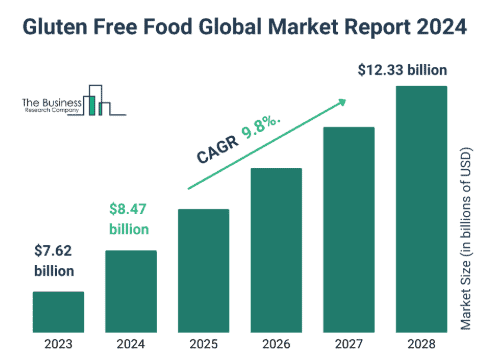 (Source: thebusinessresearchcompany.com)
(Source: thebusinessresearchcompany.com)
- By 2025, Europe is projected to account for 30% of the global gluten-free products market.
- The gluten-free beer industry in Australia grew by 24.7% in 2023.
- The gluten-free baby food market is expected to reach $431.55 million by 2027.
- The Middle East and Africa region is seeing more gluten-free products being launched, with a 9% annual growth.
- The gluten-free chocolate market is expected to grow by 15.8% from 2021 to 2026.
- Gluten-Free Diet Statistics stated that the gluten-free pet food market in Europe is expected to reach €270 million by 2025.
- Asia-Pacific is the fastest-growing market for gluten-free products, with an annual growth rate of 12%.
- The global market for gluten-free snacks is projected to reach $14.5 billion by 2026.
- The gluten-free nutraceuticals market is expected to grow by 8.2% from 2021 to 2028.
- The global gluten-free cosmetics market is expected to reach $8.3 billion by 2027.
- Sales of gluten-free convenience foods grew by 5.3% in 2020.
- The global gluten-free probiotics market is expected to grow at an 8.5% annual rate through 2027.
- The gluten-free nut butter market is expected to grow at a 7.2% annual rate from 2021 to 2026.
- The global market for gluten-free bakery items is estimated to surpass $4.78 billion by 2027.
Allergies And Celiac Diseases Statistics
- Celiac disease is a condition where eating gluten causes pain and damage to the digestive system.
- Interestingly, 60% of children and 40% of adults with Celiac disease show no symptoms.
- Around 1% of the population is affected by Celiac disease, which is roughly 30 million people in the U.S. and 7 million in the U.K. Other countries also report high numbers:
#1. 6% of Italians have Celiac.
#2. 99% of Finns are affected.
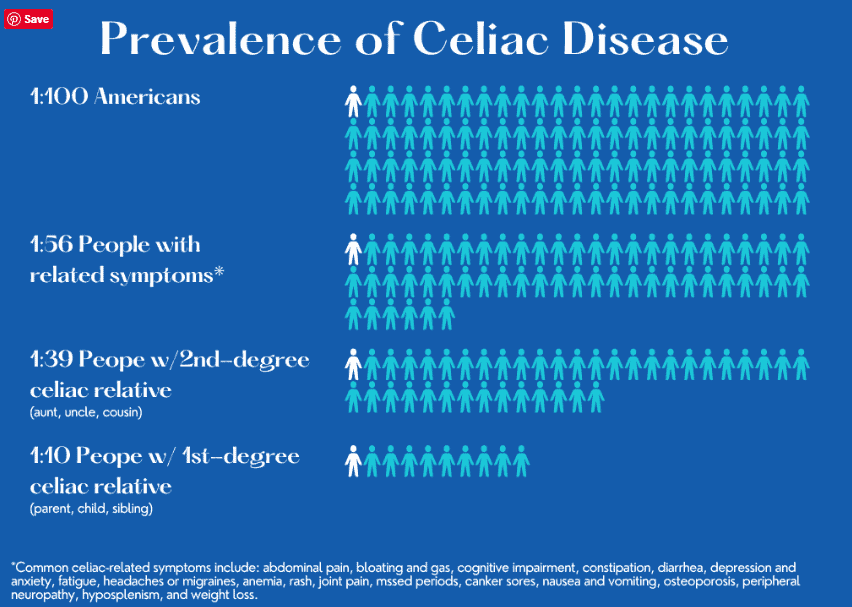 (Source: goglutenfreely.com)
(Source: goglutenfreely.com)
- Worldwide, 1.4% of people have Celiac, and the number is increasing, possibly up to 5 times since 1950.
- However, only 30% of people with Celiac disease get correctly diagnosed. This may explain why some estimates suggest only 3 million Americans have it.
- 70% of Celiac diagnoses happen in women, and the average age of diagnosis is 50.
- Some studies suggest that up to 1 in 20 Americans may have Celiac, but many people diagnose themselves.
- Since Celiac disease is an autoimmune disorder, it often appears alongside other conditions.
- Early diagnosis can help avoid additional health issues. If Celiac is diagnosed by age 4, the chance of developing other autoimmune diseases drops to 10.5%. But if it’s diagnosed at 20, the chance of getting another disease rises to 34%.
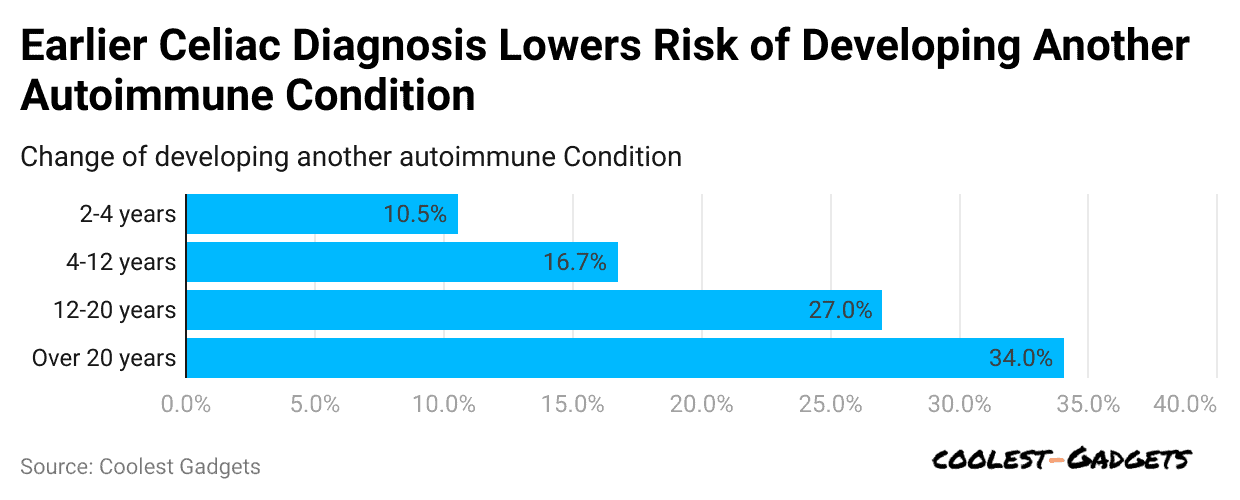 (Reference: goglutenfreely.com)
(Reference: goglutenfreely.com)
- Celiac sufferers also face a higher risk of:
#1. 69% have anaemia.
#2. 27% dealing with Lymphocytic Colitis.
#3. 12% suffering from Peripheral Neuropathy.
#4. 10% have Type 1 Diabetes.
- Besides autoimmune problems, many people with gluten intolerance also have other allergies:
#1. 28% are allergic to milk or dairy.
#2. 4% are allergic to fish.
#3. 4% have a peanut allergy.
- If Celiac is not diagnosed, medical expenses can increase by up to $1,000 more per year. Untreated Celiac disease is also linked to 6% of female infertility.
- People with Celiac disease are at a higher risk for serious health problems:
#1. 6 times more likely to die from non-Hodgkin’s lymphoma.
#2. 4 times more likely to get small bowel cancer.
-Times more likely to die from liver disease.
-Times more likely to die from pneumonia.
- Living with Celiac also impacts daily life:
#1. 50% of Celiac patients report that it heavily affects their lives, missing an average of 5 weeks from school or work each year.
#2. 31% suffer from depression.
#3. 21% experience anxiety.
#4. 7% have eating disorders.
Gluten-Free Diet Demographics Statistics
- Many lifestyle choices, like going gluten-free, are based on surveys. Since there are many reasons people choose a gluten-free diet, it’s important to understand these reasons before focusing on medical concerns. Here’s a summary from an online survey:
#1. 18% of people have been gluten-free for less than a year.
#2. 15% have been gluten-free for two years.
#3. 21% have been gluten-free for 3 to 5 years.
#4. 24% have been gluten-free for 10 years.
#5. 22% have been gluten-free for over 10 years.
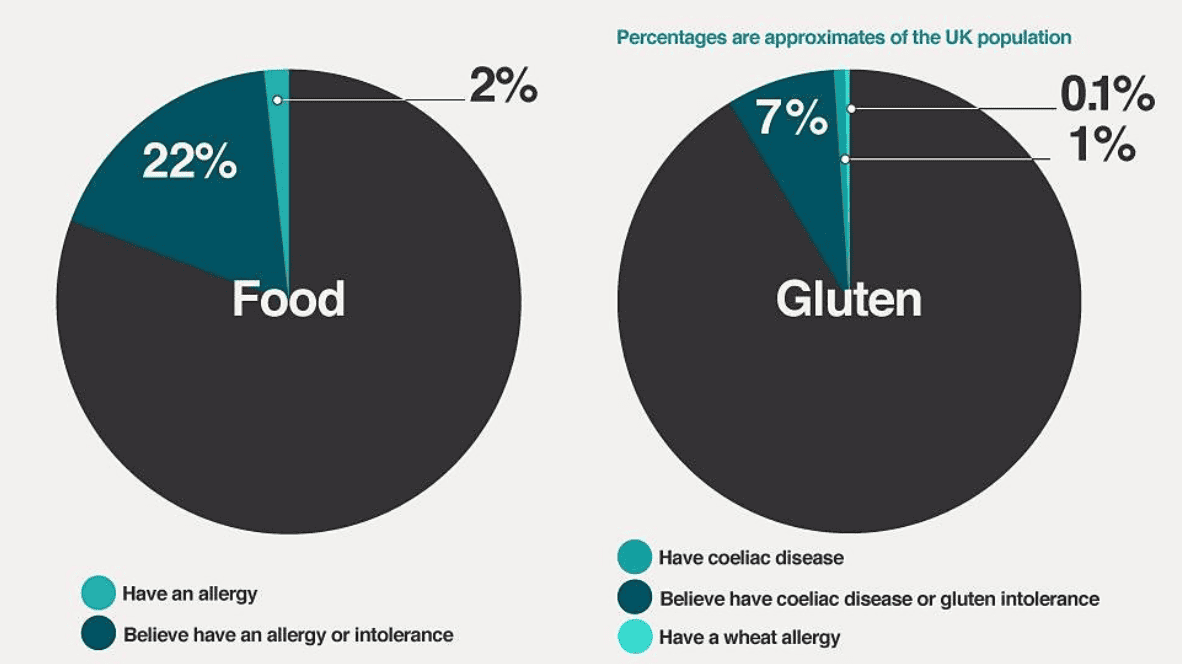 (Source: bbc.co)
(Source: bbc.co)
- Many people choose a gluten-free diet because they think it helps with health issues. Some self-diagnose their condition, while a doctor advises others due to an autoimmune disorder. Here are the top reasons why people follow a gluten-free diet:
#1. 48% do it because of Celiac Disease.
#2. 31% do it because they are gluten intolerant.
#3. 8% follow the diet due to another autoimmune condition.
#4. 80% want to reduce gastrointestinal (GI) pain.
#5. 60% try it to help with nausea.
#6. 57% use it to fight fatigue.
#7. 40% aim to relieve joint pain.
- Does going gluten-free help? Of people diagnosed with a health condition, 100% say the diet has removed their symptoms. However, only 33% of people who aren’t diagnosed report feeling better, and 3% don’t feel any improvement.
- Another study shows that nearly one-third of Americans are trying to avoid gluten for health reasons other than Celiac Disease. Among them:
#1. 42% believe it helps reduce inflammation.
#2. 37% think it’s a healthier choice.
#3. 24% believe it can aid in weight loss.
Gluten-Free Shopping Habits Statistics
- When we go shopping, many of us grab our favorite items, but how often do we pick up gluten-free products? According to a Civic Science survey on shopping habits:
- 12% of people buy gluten-free items regularly:
- 5% buy gluten-free products every time they shop.
- 7% buy gluten-free items if it’s convenient.
- On the other hand:
- 68% of people never buy gluten-free products.
- 20% buy them occasionally, but not often.
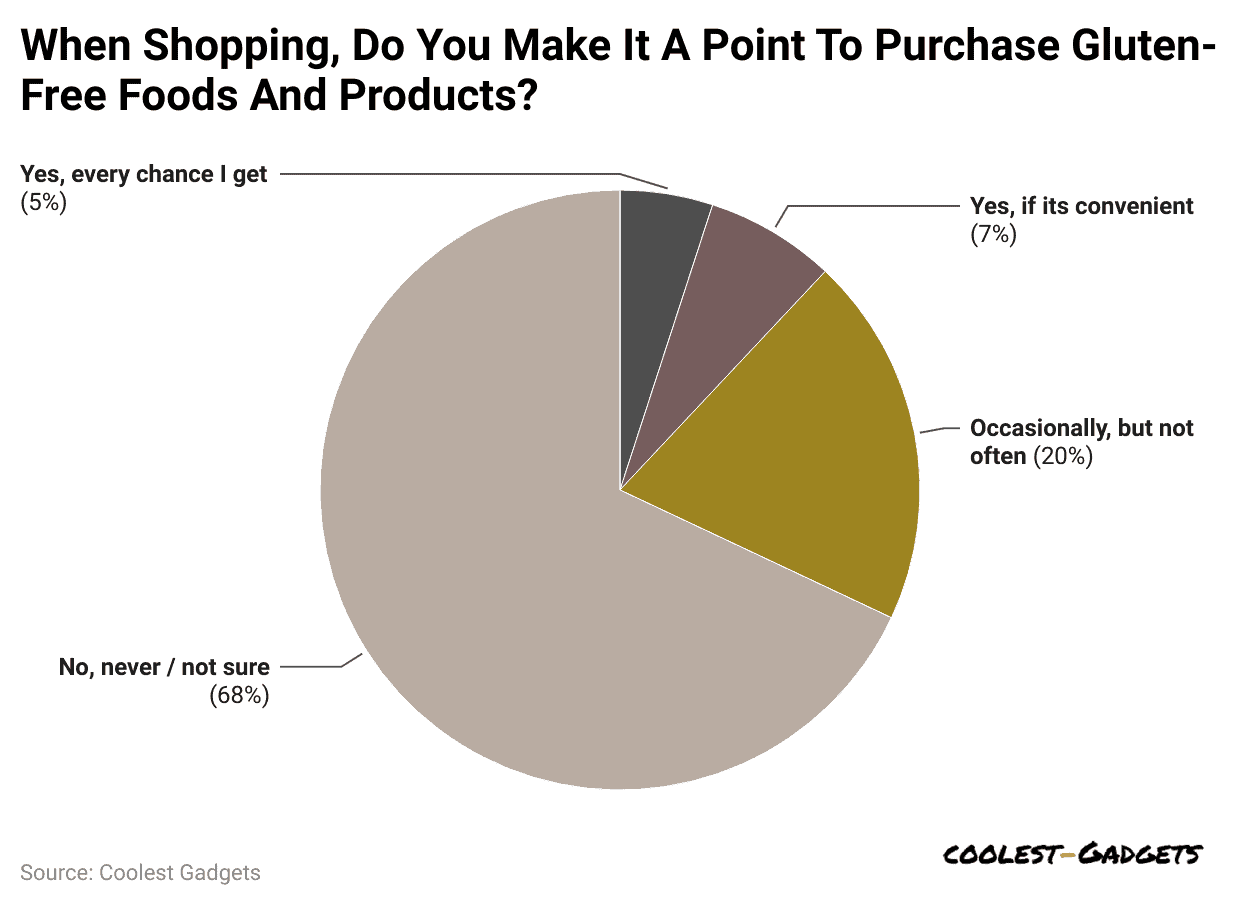 (Reference: civicscience.com)
(Reference: civicscience.com)
- Many people don’t buy gluten-free products simply because these items are not easy to find at their regular stores.
- According to survey data, 40% of adults in the U.S. shop at big grocery chains like Giant Eagle and Safeway.
- Gluten-Free Diet Statistics stated that about 25% do their grocery shopping at large stores like Walmart or Target, while 8% shop at membership-based retailers like Costco.
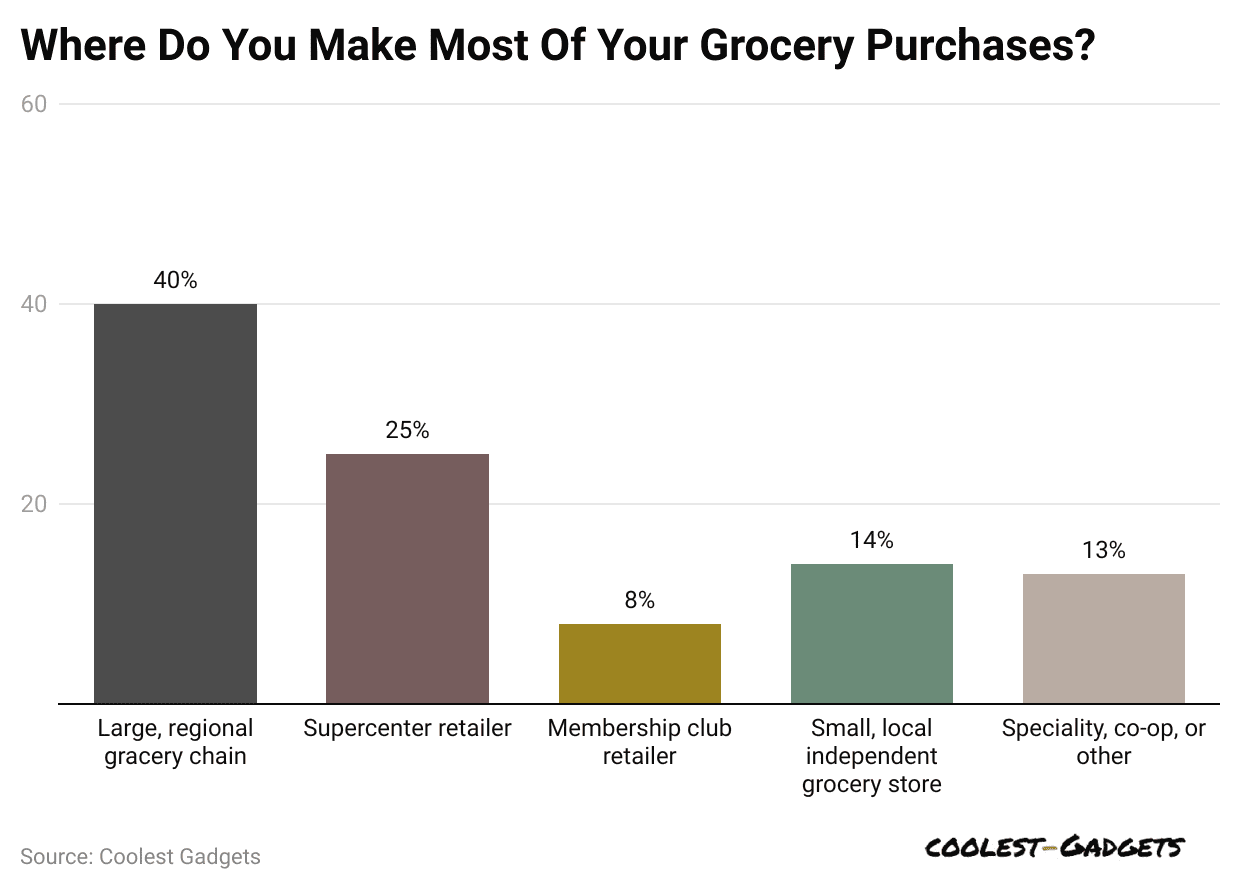 (Reference: civicscience.com)
(Reference: civicscience.com)
- Gluten-Free Diet Statistics stated that only 13% of shoppers go to speciality stores, where gluten-free products might be more available.
- This could be why 68% of people in the survey say they never buy gluten-free items, and 20% only buy them once in a while but not often.
- Just 12% of people regularly purchase gluten-free products. Out of those, 5% buy gluten-free products every time they shop, while 7% will buy them if it’s easy or convenient.
Conclusion
Cutting back on carbs can be helpful, but completely removing gluten from your diet can be tough and expensive. For those with Celiac disease or gluten intolerance, avoiding gluten is a must. For the rest of us, it’s best to reduce gluten in moderation. Always check with a doctor before making big changes to your diet, and keep an eye on how your health changes as you go.
We have shed enough light on Gluten-Free Diet Statistics through this article.
Sources
FAQ.
Even though many people follow it, there isn’t much proof that a gluten-free diet is good for those who don’t have gluten sensitivity, like celiac disease or non-celiac gluten intolerance. However, for those with celiac disease, a gluten-free diet is the only treatment that works.
Rice doesn’t contain gluten, so it’s a good option for people who need to avoid gluten because of celiac disease, gluten intolerance, or other health reasons.

Saisuman is a talented content writer with a keen interest in mobile tech, new gadgets, law, and science. She writes articles for websites and newsletters, conducting thorough research for medical professionals. Fluent in five languages, her love for reading and languages led her to a writing career. With a Master’s in Business Administration focusing on Human Resources, Saisuman has worked in HR and with a French international company. In her free time, she enjoys traveling and singing classical songs. At Coolest Gadgets, Saisuman reviews gadgets and analyzes their statistics, making complex information easy for readers to understand.




